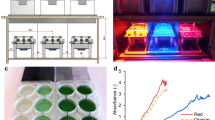Abstract
Illumination of a liquid culture of Synechococcus 6301 at high photon flux density (PFD) elicits a time-dependent first-order exponential decline in relative quantum yield of photosynthetic O2 evolution to some steady-state value. Full photosynthetic activity is restored, also as a time-dependent first-order process, when the photoinhibited culture is transferred to lower PFD. Temperature and irradiation dependence of photoinhibition were measured under conditions which precluded simultaneous recovery from photoinhibition. Also the temperature and irradiation dependence of recovery from photoinhibition were determined under conditions which precluded simultaneous photoinhibition. Kinetics of photoinhibition were sensitive to PFD but relatively independent of temperature. Kinetics of recovery saturated at low PFD but were very temperature dependent at all PFDs. A general equation can be written to predict the change in photosynthetic activity versus time when a cell culture is placed at photoinhibitory PFD, assuming that first-order exponential photoinhibition and first-order exponential recovery from photoinhibition occur simultaneously. The equation can be made specific if the values of the kinetic constant for photoinhibition and for recovery from photoinhibition are known for the particular environmental conditions to which the cells are exposed. These values can be obtained by independently measuring the kinetics of photoinhibition without simultaneous recovery and the kinetics of recovery without simultaneous photoinhibition. The curve of photosynthetic activity versus time for cells placed at high PFD, which is predicted by this equation, precisely fits the experimentally determined kinetics of photoinhibition. This correlation remains valid over a wide range of temperatures and PFDs. Identical results were obtained with the marine cyanobacterium Synechococcus 7002. We conclude that the extent of net photoinhibition over a broad range of conditions represents a sum of individual rates of simultaneous photoinhibition and recovery from photoinhibition. The results support previous proposals that a protein required for photosystem II activity becomes functionally depleted during photoinhibition because protein synthesis or assembly into the membranes cannot keep up with the rate of its inactivation at excessively high PFDs. We also conclude that photoinhibition and light-dependent chilling sensitivity are manifestations of the same phenomenon.
Similar content being viewed by others
Abbreviations
- CAP:
-
chloramphenicol
- Chl:
-
chlorophyll
- PFD:
-
photon flux density
- PSII:
-
photosystem II
References
Buchecker, R., Liaaen-Jensen, S., Borch, G., Siegelmen, H.W. (1976) Carotenoids of Anacystis nidulans structures of caloxanthin and nostoxanthin. Phytochemistry 15, 1015–1018
Demmig-Adams, B. (1990) Carotenoids and photoprotection in plants: A role for the xanthophyll zeaxanthin. Biochim. Biophys. Acta 1020, 1–24
Greer, D.G., Laing, W.A. (1988) Photoinhibition of photosynthesis in intact kiwifruit (Actinida deliciosa) leaves: Recovery and its dependence on temperature. Planta 174, 159–165
Greer, D.G., Laing, W.A. (1989) Effect of temperature and PFD on the susceptibility of leaves to photoinhibition and recovery. In: Current research in photosynthesis, vol. 2, pp. 365–372, Baltscheffsky, M., ed. Kluwer Academic Publishers, Dordrecht, The Netherlands
Kok, B. (1956) On the inhibition of photosynthesis by intense light. Biochim. Biophys. Acta 21, 234–244
Kratz, W.A., Myers, J. (1955) Nutrition and growth of several blue-green algae. Am. J. Bot. 42, 282–287
Kyle, D.J. (1987) The biochemical basis for photoinhibition of photosystem II. In: Photoinhibition, pp. 197–226, Kyle, D.J., Osmond, C.B., Arntzen, C.J., eds. Elsevier, Amsterdam
Kyle, D.J., Ohad, I. (1986) The mechanism of photoinhibition in higher plants and green algae. In: Photosynthesis III, Photosynthetic membranes, pp. 468–475, Staehelin, L.A., Arntzen, C.J., eds. Springer Verlag, Berlin
MacKinney, G. (1941) Absorption of light by chlorophyll solutions. J. Biol. Chem. 140, 315–322
Ögren, E. (1991) Prediction of photoinhibition of photosynthesis from measurements of fluorescence quenching components. Planta 184, 538–544
Ohad, I., Kyle, D.J., Arntzen, C.J. (1984) Membrane-protein damage and repair-removal and replacement of inactivated 32-kilodalton polypeptides in chloroplast membranes. J. Cell Biol. 99, 481–485
Powles, S.B. (1984) Photoinhibition of photosynthesis induced by visible light. Annu. Rev. Plant Physiol. 35, 5–44
Provasoli, L., McLaughlin, J.J.A., Droop, M.R. (1957) The development of artificial medium for marine algae. Arch. Mikrobiol. 25, 392–428
Rao, V.S.K., Brand, J.J., Myers, J. (1977) Cold shock syndrome in Anacystic nidulans. Plant Physiol. 59, 965–969
Rieske, J.S., Lumry, R., Spikes, J.D. (1959) The mechanism of the photochemical activity of isolated chloroplasts. III. Dependence of velocity on light intensity. Plant Physiol. 34, 293–300
Rippka, R., Deruelles, J., Waterbury, J.B., Herdman, M., Stanier, R.J. (1979) Generic assignments, strain histories and properties of pure cultures of cyanobacteria. J. Gen. Microbiol. 111, 1–61
Samuelsson, G., Lonneborg, A., Rosenqvist, E., Gustavsson, P., Öquist, G. (1985) Photoinhibition and reactivation of photosynthesis in the cyanobacterium Anacystis nidulans. Plant Physiol. 79, 992–995
Zhao, J., Brand, J.J. (1989) Sequential events in the photoinhibition of Synechocystis under sodium stress. Plant Physiol. 91, 91–100
Author information
Authors and Affiliations
Additional information
The authors thank Rockey Butler and Donna Scott for performing many of the preliminary experiments which led to this research. This work was supported by R.A. Welch and University Research Institute Grants to J.J.B.
Rights and permissions
About this article
Cite this article
Wünschmann, G., Brand, J.J. Rapid turnover of a component required for photosynthesis explains temperature dependence and kinetics of photoinhibition in a cyanobacterium, Synechococcus 6301. Planta 186, 426–433 (1992). https://doi.org/10.1007/BF00195324
Accepted:
Issue Date:
DOI: https://doi.org/10.1007/BF00195324




